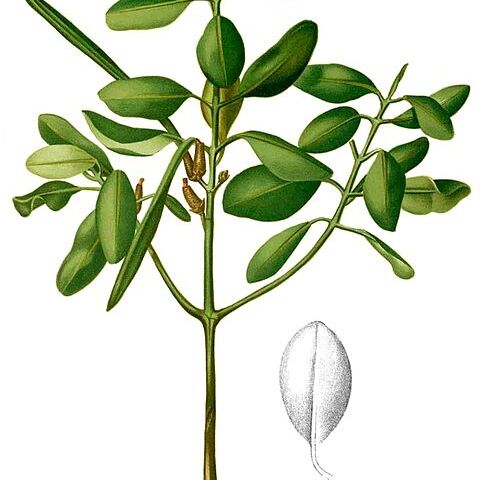Shrub or tree up to 15(-25) m by 20 cm, often degenerating into a bushy shrub under unfavourable conditions. Stem base often with small stilt-roots. Bark light grey, fairly smooth with fine lenticular fissures. Leaves obovate to obovate-oblong, rarely elliptic-oblong, 5-11.5 by 2-7.5 cm, obtuse or sometimes slightly emarginate, base cuneate, margins often wavy; petioles 1.5-3.5 cm. Stipules 1.25-2.5 cm long. Inflorescences often on the terminal nodes of the new shoot, usually resinous, (2-)4-10-flowered. Calyx lobes erect in flower, widely patent, reflexed in fruit, ovate, acuminate, 4-5 mm long; tube c. 2 mm high. Petals oblong, white, turning brown, coherent at the base with uncinate hairs, limb c. 3.5 mm long, with 3 clavate, apical appendages c. 0.5 mm long. Stamens 3-5 mm, alternately longer and shorter, anthers slightly ovoid, sagittate, much shorter than the filaments. Superior part of the ovary 1.5 mm high, style 2 mm, entire. Fruit ovoid, 1½-2½ cm long, calyx lobes soon reflexed; hypocotyl club-shaped, sharply angular, 15-25(-35) cm long. Seeds 1(-2).
Glabrous shrub or small bushy-topped tree up to 6 m. tall; bark grey-brown.. Leaves yellow-green; blade broadly elliptic to obovate, 3–9.5 cm. long, 1.4–4.8 cm. broad, apex rounded, base cuneate; petiole up to 2.5 cm. long (in Africa).. Inflorescence 4–8-flowered; peduncle ± 1 cm. long; bracteoles deltoid, apex obtuse, 2 mm. long; buds ovoid, pentagonous.. Calyx-tube ± 1.5 mm. long, reddish brown; lobes 5, pale green, triangular, ± 4 mm. long, extreme apex obtuse or acute.. Petals 5, white, oblong, ± 3 × 1 mm., glabrous, truncate apically and bearing (in our area) 3 distinctly clavate appendages.. Disc composed of 5 ± separate lobed elements.. Stamens 10; filaments white, 3.0 mm. long; anthers ochre, 0.3 mm. long, basifixed.. Ovary pale green; placentae axile, biovulate.. Hypocotyl extended up to 25 cm. long from fruit, sharply longitudinally ridged, ± swollen subdistally, sharply pointed.. Fig. 2.
Shrubs or trees, 2-5 m tall. Trunks with buttresses or small stilt roots. Bark brownish. Stipules lanceolate, 1-2 cm. Petiole 1-3 cm; leaf blade obovate to obovate-oblong, 4-9 × 2-5 cm, base cuneate, apex obtuse to sometimes slightly emarginate. Inflorescences 4-10-flowered; peduncle 1-2 cm. Pedicel to 2 mm. Calyx 6-7 mm, erect or slight spreading in flower, widely spreading or reflexed in fruit. Petals oblong, ca. 4 mm, margins fringed with trichomes and slightly cohering, apex with 3 club-shape terminal appendages. Stamen filaments 3-5 mm, shorter than calyx lobes; anthers less than 1 mm. Hypocotyl 15-30 cm, apex sharply pointed. Fl. autumn-winter, fr. winter.
Shrub or tree 2–15 m high, often with buttresses or small stilt roots; knee roots occasionally present; bark brownish, sometimes papery. Leaves obovate to broadly spathulate, obtuse or emarginate; lamina 3–9 cm long, 1.5–6 cm wide; stipules up to 2.5 cm long. Inflorescence 4–10-flowered; peduncle 1–2 cm long; pedicels to 2 mm. Sepals c. 4.5 mm long, erect or slightly spreading in flower, widely spreading or reflexed in fruit. Petals oblong, thickened along mid-line, with 3 club-shaped terminal appendages; margins fringed with hairs, lightly cohering. Staminal filaments c. 3 mm long; anthers less than 1 mm long. Hypocotyl 12–35 cm long, sharply pointed.
An evergreen tree. It grows 8-25 m high. It can also be a bush in some locations. It has stilt roots. These are like five fingers rising from the mud. The bark is light brown. The leaves are green and shiny. They are leathery and oval shaped. The tip is rounded and they taper near the base. The leaves are 7 cm long by 3.5 cm wide. The flowers are creamy white. They are star shaped. They have many red stamens. The fruit are 20 cm long. They are cone shaped. They are greenish brown.
Leaf-lamina usually 4–9 x 2–5 cm., elliptic to obovate; apex rounded to refuse; base narrowed into the petiole; midrib rather prominent below; petiole usually 1–3 cm. long; stipules 1–2 cm. long, lanceolate, plicate-involute initially, very acute at the apex and truncate at the base.
Shrub or small tree up to 6(15) m. high; branches terete or slightly compressed towards the extremities, smooth, with elliptic to ± deltate or subcircular scars of the petioles of the fallen leaves and annular scars of the fallen stipules; bark brown to grey.
Petals 3·5 x 2 mm., oblong or obovate-oblong, truncate and bearing 3 distinct very short glandular appendages at the apex, shortly cohering a little below the middle by the uncinate-hairy margins, the base slightly narrower than the apex, white or cream.
Calyx reddish-brown; calyx-tube c. 2·5 mm. long; calyx-lobes c. 5 mm. long, triangular or ovate-triangular, acute at apex, fleshy, abaxial surface glossy, adaxial surface paler and mat, with a longitudinal thickened ridge.
Flowers 5-merous, subsessile; bracts and bracteoles c. 2 mm. long, ± deltate or ovate-circular, obtuse or subrounded at the apex; flower-buds c. 5 x 4 mm., ellipsoid-ovoid, subpentagonal, glabrous.
Stamens 10; filaments 3–4 mm. long, ± filiform, narrowed and bent at the apex and slightly swollen at the base; anthers 0·5–0·7 mm. long, ovoid-sagittate, acute at the apex, ochraceous.
Inflorescences (3)4–8-flowered; principal peduncle up to 1·5 cm. long, very shortly or obsoletely 2–3-forked at the apex.
Hypocotyl extended up to 26 cm. from the fruit while on the tree, sharply longitudinally ridged, ± swollen subdistally.
Ovary c. 3 mm. long, ovoid, pale green; style c. 1·5 mm. long, thickened at the base and minutely 3-lobed at the apex.
Disk composed of 5, ± separate, 2-lobed elements.


